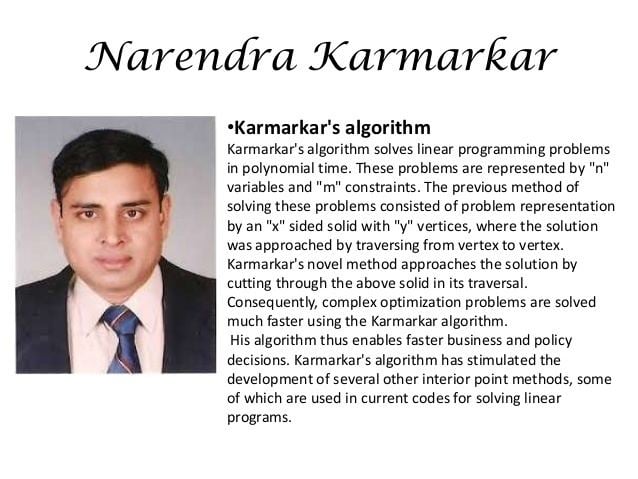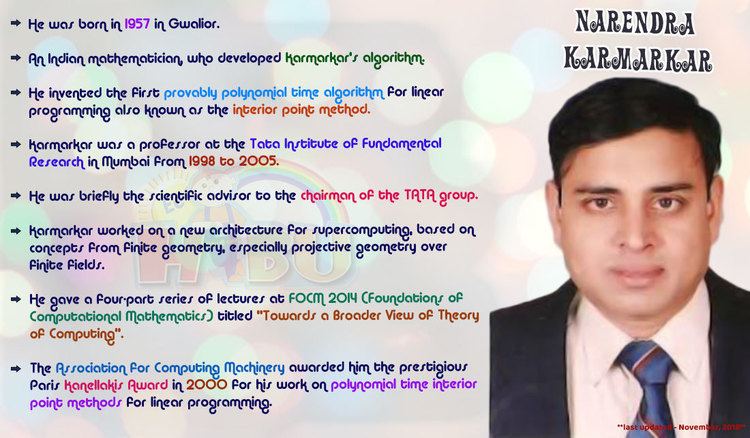Doctoral advisor Richard M. Karp Role Mathematician | Name Narendra Karmarkar | |
 | ||
Alma mater Indian Institute of Technology Bombay, California Institute of Technology, University of California, Berkeley Thesis Coping with NP-Hard Problems (1983) Education Indian Institute of Technology Bombay, California Institute of Technology, University of California, Berkeley Fields Mathematics, Computer Science Similar Subhash Khot, Raman Parimala, Ramaiyengar Sridharan | ||
Narendra Karmarkar
Narendra Krishna Karmarkar (born 1957) is an Indian mathematician, who developed Karmarkar's algorithm. He is listed as an ISI highly cited researcher.
Contents
- Narendra Karmarkar
- Narendra Karmarkar Ex Professor TIFR Railway Reforms Governance 2017
- Biography
- Karmarkars algorithm
- Paris Kanellakis Award
- Galois geometry
- Current investigations
- References

Narendra Karmarkar, Ex Professor, TIFR : Railway Reforms & Governance 2017
Biography

Karmarkar received his B.Tech in Electrical Engineering from IIT Bombay in 1978, M.S. from the California Institute of Technology in 1979, and Ph.D. in Computer Science from the University of California, Berkeley in 1983 under the supervision of Richard M. Karp.

In 1973, Karmarkar topped the prestigious Indian Institute of Technology Joint Entrance Examination.

He invented the first provably polynomial time algorithm for linear programming also known as the interior point method. The algorithm is a cornerstone in the field of linear programming. He published his famous result in 1984 while he was working for Bell Laboratories in New Jersey. Karmarkar was a professor at the Tata Institute of Fundamental Research in Mumbai from 1998 to 2005. He was briefly the scientific advisor to the chairman of the TATA group. He is currently working on a new architecture for supercomputing.
Karmarkar has received a number of awards:
Karmarkar's algorithm
Karmarkar's algorithm solves linear programming problems in polynomial time. These problems are represented by "n" variables and "m" constraints. The previous method of solving these problems consisted of problem representation by an "x" sided solid with "y" vertices, where the solution was approached by traversing from vertex to vertex. Karmarkar's novel method approaches the solution by cutting through the above solid in its traversal. Consequently, complex optimization problems are solved much faster using the Karmarkar algorithm. A practical example of this efficiency is the solution to a complex problem in communications network optimization where the solution time was reduced from weeks to days. His algorithm thus enables faster business and policy decisions. Karmarkar's algorithm has stimulated the development of several interior point methods, some of which are used in current codes for solving linear programs.
Paris Kanellakis Award
The Association for Computing Machinery awarded him the prestigious Paris Kanellakis Award in 2000 for his work on polynomial time interior point methods for linear programming.
Galois geometry
After working on the Interior Point Method, Karmarkar worked on a new architecture for supercomputing, based on concepts from finite geometry, especially projective geometry over finite fields.
Current investigations
Currently, he is synthesizing these concepts with some new ideas he calls sculpturing free space (a non-linear analogue of what has popularly been described as folding the perfect corner). This approach allows him to extend this work to the physical design of machines. He is now publishing updates on his recent work, including an extended abstract. This new paradigm was presented at IVNC, Poland on 16 July 2008, and at MIT on 25 July 2008. Some of his recent work is published at ieeexplore. He delivered a lecture on his on going work at IIT Bombay in September 2013. He gave a four-part series of lectures at FOCM 2014 (Foundations of Computational Mathematics) titled "Towards a Broader View of Theory of Computing". First part of this lecture series is available at Cornell archive.
